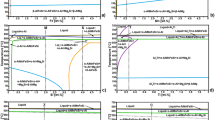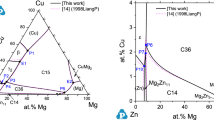Abstract
Wedge castings were produced using six Al–Zn–Mg–Cu aluminum alloys with zinc concentrations ranging from 8 to 15 wt%, Zn/Mg ratios ranging from 1.7 to 6.5, and copper ranging from 0.6 to 1 wt%. Thermal analysis and microstructural characterization of the samples in the as-cast, solution-treated, and aged conditions were performed and compared to Calculation of Phase Diagram simulations. The calculated phase stability in the alloys was overall remarkably accurate for both the solidification and equilibrium phase formation. Additional equilibrium calculations were made to determine the range of alloying concentrations that would not contain eutectic T or η phase. The phase stability in a total of 195 chemistries was calculated.


























Similar content being viewed by others
References
J.R. Davis (ed.), ASM Specialty Handbook Aluminum and Aluminum Alloys (ASM International, 1993), pp. 89–90, 92, 113–114, 697
L.F. Mondolfo, Aluminum Alloys: Structure and Properties (Butterworths Publishers, London, 1976), p. 652
G.E. Totten, D.S. MacKenzie (eds.), Handbook of Aluminum: Vol. 1: Physical Metallurgy and Processes (CRC Press, Boca Raton, 2003), p. 190
J.E. Hatch, (ed.), Aluminum: Properties and Physical Metallurgy (American Society for Metals, Ohio, 1984), pp. 51–52, 79
J.-J. Yu, X.-M. Li, X.-Q. Yu, Thermodynamic analyse on equilibrium precipitation phases and composition design of Al–Zn–Mg–Cu alloys. J. Shanghai Jiaotong Univ. (Sci.) 17(3), 286–290 (2012)
T. Sheppard, Extrusion of Aluminum Alloys (Kluwar, Berlin, 1999)
N. Saunders, The application of calculated phase equilibrium to multi-component aluminum alloys. J. JILM 51, 141–150 (2001)
S.T. Lim, I.S. Eun, S.W. Nam, Control of equilibrium phases (M, T, S) in the modified aluminum alloy 7175 for thick forging applications. Mater. Trans. Jpn. Inst. Metals 44(1), 181–187 (2003)
J.K. Park, A.J. Ardell, Precipitate microstructure of peak-aged 7075 Al. Scripta Mater. 22, 1115–1119 (1988)
D. Godard, P. Archambault, E. Aeby-Gautier, G. Lapasset, Precipitation sequences during quenching of the AA 7010 alloy. Acta Mater. 50, 2319–2329 (2002)
J.K. Park, A.J. Ardell, Microstructures of the commercial 7075 Al alloy in the T651 and T7 tempers. Metall. Trans. A 14A, 1957–1965 (1983)
J.T. Staley, Microstructure and toughness of high-strength aluminum alloys. Prop. Relat. Fract. Toughness ASTM Spec. Tech. Publ. 605, 71–103 (1975)
C. Mondal, A.K. Mukhopadhyay, On the nature of T(Al2Mg3Zn3) and S(Al2CuMG) phases present in as-cast and annealed 7055 aluminum alloy. Mater. Sci. Eng. A 391, 367–376 (2005)
A.J. Morris, R.F. Robey, P.D. Couch, E. De los Rios, A comparison of the damage tolerance of 7010 T7451 and 7050 T7451. Mater. Sci. Forum. 242, 181–186 (1997)
N. Deshpande, A.M. Gokhale, D.K. Denzer, J. Liu, Relationship between fracture toughness, fracture path and microstructure of 7050 aluminum alloy: part 1. Quantitative characterization. Metall. Mater. Trans. A 29A, 1191–1201 (1998)
D.J. Strawbridge, W. Hume-Rothery, A.T. Little, The constitution of aluminum–copper–magnesium–zinc alloys at 460 C. J. Inst. Metals 74, 191–225 (1947)
P. Sainfort, C. Sigli, G.M. Raynaud, Ph Gomiero, Structure and property control of aerospace alloys. Mater. Sci. Forum 242, 25–32 (1997)
N. Kamp, I. Sinclair, M.J. Starink, Toughness-strength relations in the overaged 7449 Al-based alloy. Metall. Mater. Trans. A 33A, 1125–1136 (2002)
N. Saunders, The modelling of stable and metastable phase formation in multi-component Al-alloys, in Proceedings of the 9th International Conference on Aluminum Alloys, Brisbane, Australia (2004)
J. Yu, X. Li, Modelling of the precipitated phases and properties of Al–Zn–Mg–Cu alloys. J. Phase Equilib. Diffus. 32(4), 350–360 (2011)
J.-J. Yu, X.-M. Li, X.-Q. Yu, Thermodynamic analyse on equilibrium precipitatino phases and composition design of Al–Zn–Mg–Cu alloys. J. Shanghai Jiaotong Univ. (Sci.) 17(30), 286–290 (2012)
E. Druschitz, R. Foley, J. Griffin, High strength cast Al–Zn–Cu–Mg aluminum: solution treating and aging study. AFS Trans. 121, 231–241 (2013)
JMatPro v7.0.0, Sente Software Ltd., (Surrey Technology Centre, Surrey), p. 272
P.P. Chintalapati, J.A. Griffin, R.D. Griffin, Improved mechanical properties of lost foam cast A356 and A319 aluminum solidified under pressure. AFS Trans. 115, 881–897 (2007)
Author information
Authors and Affiliations
Corresponding author
Technical Review and Discussion
Technical Review and Discussion
Microstructural Characterization and Thermodynamic Simulation of Cast Al-Zn-Mg-Cu Alloys
Maria D. David, Robin D. Foley, John A. Griffin, Charles A. Monroe; The University of Alabama at Birmingham, Birmingham, AL, USA
Reviewer:
Authors can use JMatPro to calculate phase diagram for the base alloy. It would be helpful to add a phase diagram of baseline alloy or the alloy associated with cooling curves they measured in Figures 6 or 7 since the complete description of solidification sequence of the alloys they studied is not included.
Authors:
The phase diagram below is generated from JMatPro Scheil calculations. For this diagram, we used the alloying content of the Low Zn-Low Mg in the paper (see Table 2 for composition) and varied the Mg content. This diagram shows the solidification sequence for all 3 experimental low zinc alloys:
For the Low Zn-Medium Mg and Low Zn-Low Mg, the eta phase forms after the alpha. The T phase forms after the alpha for the Low Zn-High Mg. It may not be too clear in the diagram since the area is too small, but for a Mg content range that has both T and eta in its solidified microstructure: between 2.18 and 2.31 wt % Mg, the eta phase forms first, while at 2.31 to 3.5wt%Mg, the T formation precedes eta.

Reviewers:
Can you verify the accuracy of the composition from the EDS scans?
Authors:
We did 4 scans for each phase (we picked relatively coarse particles to avoid inclusion of the Al-matrix in the measurements) and presented the average as the final phase composition (individual measurements were significantly comparable to each other; thus, 4 scans for each phase were considered sufficient).
Reviewers:
How was curve fitting done for Figures 9, 11, 13 and 17?
Authors:
In plots shown in Figures 9 , 11 , 13 , and 17 , simple linear regression (using Excel) with the intercept set to 0 was used to show the correlation between the calculated values and the experimental measurements. The relatively low correlation for Figure 11 (plot of T where metal is fully solid) can be attributed to the sensitivity of the predicted/calculated temperature value to the defined solidification cut-off in the thermodynamic simulations. As we have mentioned in the Results and Discussion section of the paper, this could also be due to the Scheil-Gulliver simplification that diffusion in the solid is negligible.
Rights and permissions
About this article
Cite this article
David, M.D., Foley, R.D., Griffin, J.A. et al. Microstructural Characterization and Thermodynamic Simulation of Cast Al–Zn–Mg–Cu Alloys. Inter Metalcast 10, 2–20 (2016). https://doi.org/10.1007/s40962-015-0006-2
Published:
Issue Date:
DOI: https://doi.org/10.1007/s40962-015-0006-2




